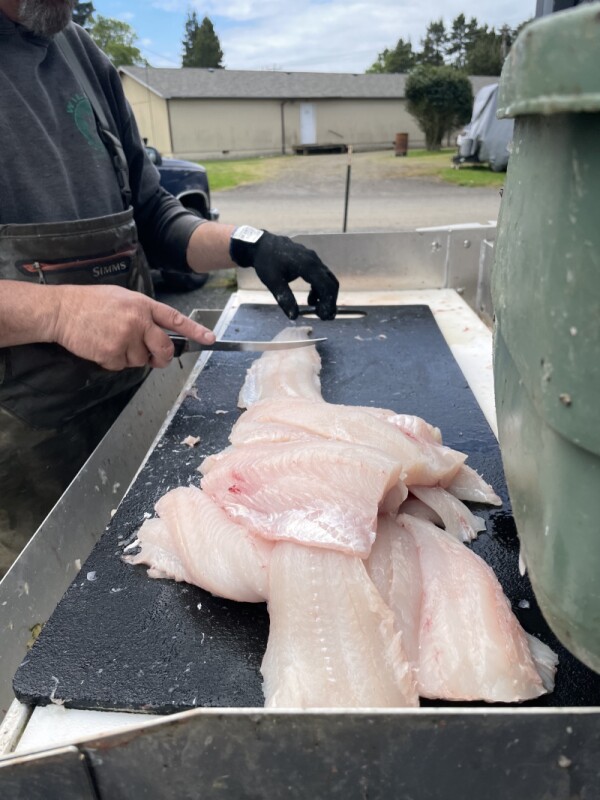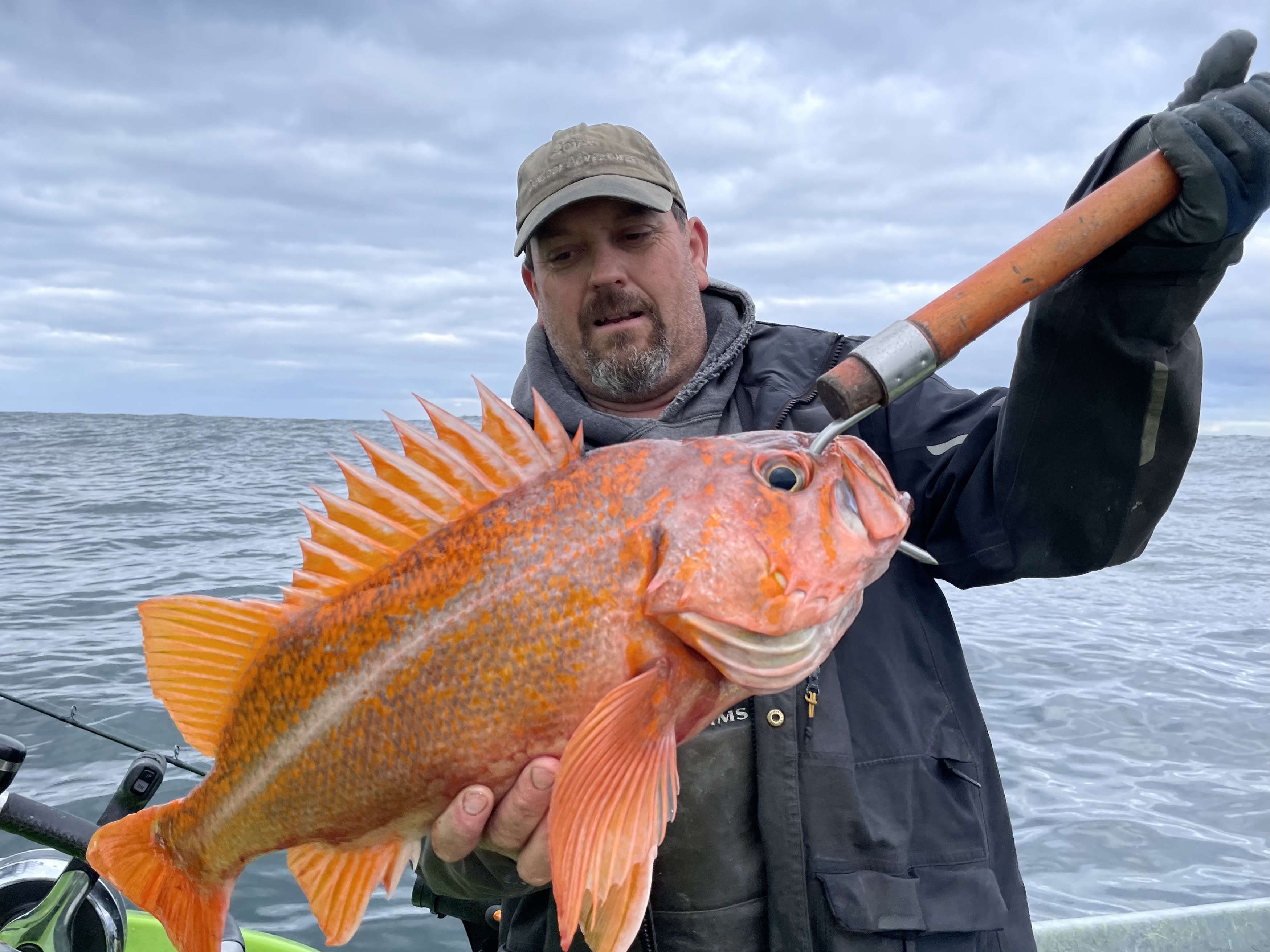The Pacific City dory fleet has been around for decades. In 1979, when this writer first heard about the fishery, it was mostly a commercial endeavor pursued with homemade boats.
While there are still a few commercial boats in the fleet, it has evolved into a largely charter operation. The current generation takes passengers out in the morning to catch whatever the sea is offering at the time. In late May, the offerings include ling cod, rockfish, and Dungeness crab.
Longtime charter dory operator Bruce Goins is meeting his crew for the day in the parking lot of the Pelican Brewery in Pacific City.
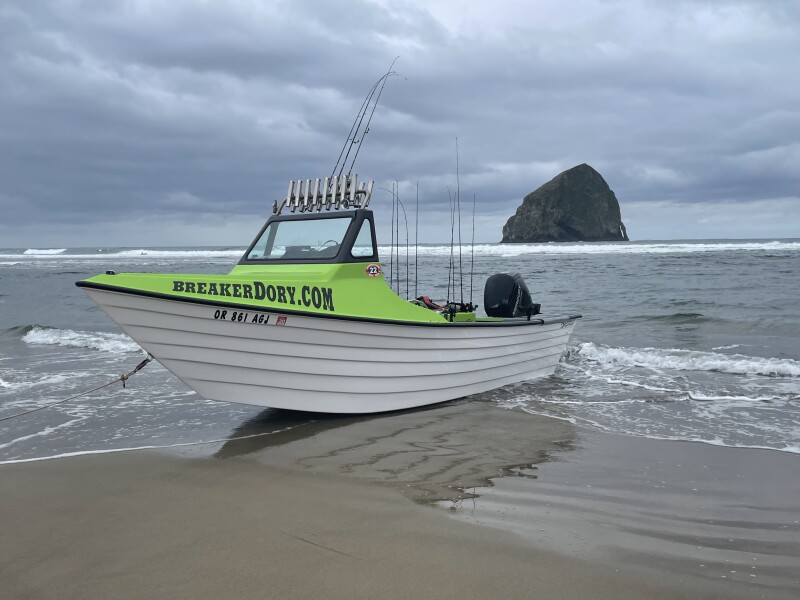
“You guys get in the boat, you stay in the boat,” Goins tells his three fishermen - myself, his friend Greg Noffsinger, and Jonathon Beals, a young guy who’s been recruited to fill the boat. We’ll be heading out in Goin’s Breaker Dory (National Fisherman 2021), built locally by Tony Butkovich.
Working with an ever-shifting cast of characters, Goins is direct and no-nonsense. He has to be. Getting a dory off the beach and out to the fishing grounds presents the biggest challenge in the day of an Oregon dory fisherman.
Goins gets out of the truck and hands a few bucks to TJ, a young man who is his boat-holder. Things happen fast after that. Goins backs the boat toward the water, hits the brakes at just the right moment, and his 22-foot dory slides with us into the shallow surf. TJ, in chest waders, grabs the corner of the boat and waits for Goins to park and return. Moments later, our skipper slides in over the stern and signals TJ, who pushes us into deeper water.
“I was watching the breakers on the point,” Goins explains later. “I saw a big set come through, so I thought we were okay.” Surprise!
Goins signals TJ to push off. He starts the 115-hp Mercury, lowers it, and guns it into the surf. It’s a moment of reckoning as he finds himself, and us, facing a surprisingly big set rolling in from across the Pacific. We slam through some breakers and then he guns it toward a swell starting to stand up in front of us. We top it before it breaks and come crashing down the other side. We race up the next one, fly off the top, and free fall down the back, slamming down hard. A cooler tips over and a pile of jigs flies off the console onto the deck.
As we go over another and then another wave, everyone hangs on with knees bent to take the shock, until the moment comes when we roll over the last big swell. We were finally through.
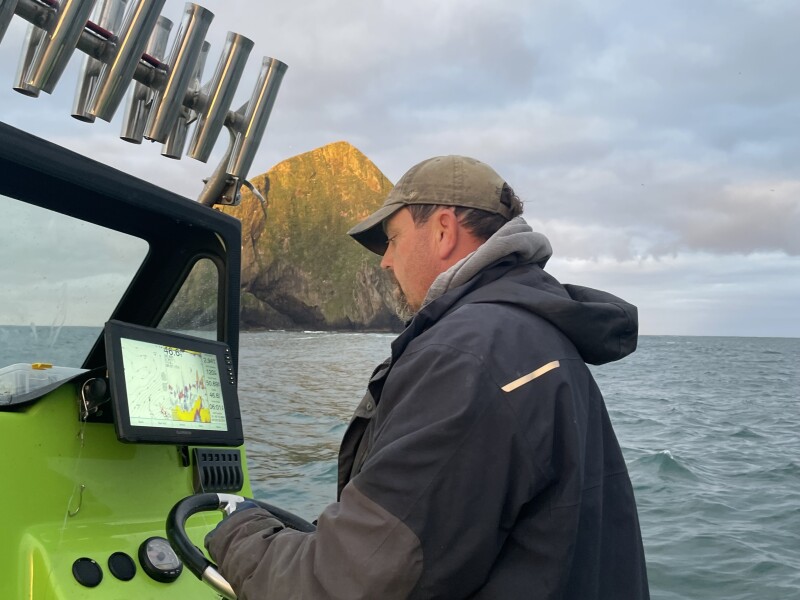
Goins gathers up the coolers and jigs and other things that have flown all around the boat. “Well that was not exactly textbook,” he says. “That was a bit of an ass puckered.”
“It was fun,” I say. “I like to know I’m on the ocean.”
Beals, in the stern, smiles. “Was that different?” he asks in innocence, unfazed.
“Yes,” laughs Goins. “If one of them had broke before we got there it would have been interesting. I had to gun it to get up to them in time. You notice I wasn’t worried about the cooler on deck.”
Goins has been driving dories over the surf in Pacific City for 30 years. “I had a dory when I was younger,” he says. “Then I got married and had kids and something had to go. I worked in the paper mill for 17 years, but then I saw the writing on the wall and came back to this.” Goins started his fishing business in 2010 and never looked back.
With the excitement of getting through the surf over, he gets down to business. Goins works with a Garmin split screen fish finder that reveals sea bass about two fathoms below the surface, and he spots schools of what he knows are black sea bass feeding on crab spawn.
“Alright,” says Goins. “I’m going to start you guys off with spinning rods. You’re going to cast out, let it drop a few seconds, and then reel it in easy. They’re not hungry—see all that spawn?” he says pointing to the Garmin. “You’re going to have to get it right in front of them.”
The three experienced fishermen cast out, but 20-year-old Beals calls out first. “Got one, got one!” Beals has followed Goins’s directions perfectly and lands the first fish.
“They’re just chasing the worm,” says Goins. “It’s all about y
our speed, once you get the right speed you’ll catch fish.” So, we concentrate on how fast we bring our silicone worms through the school of fish. I’m watching Beals crank and match his speed.
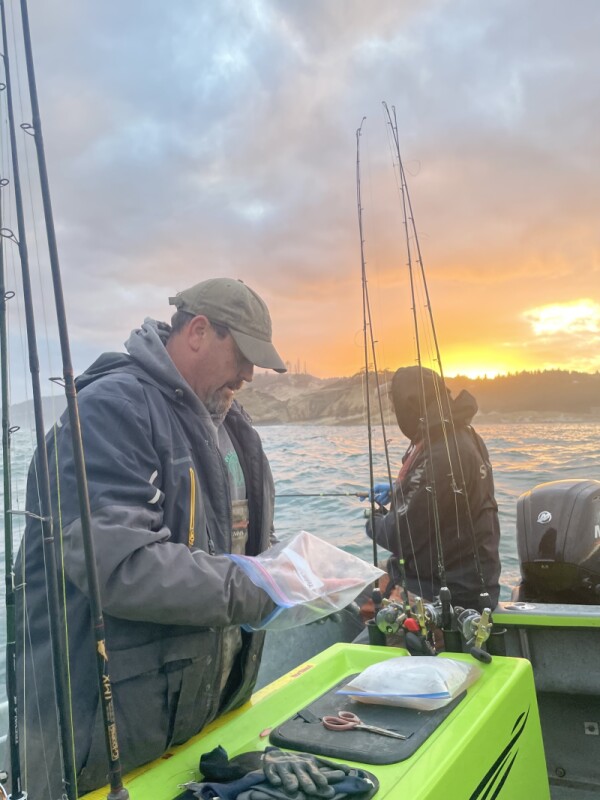
Beals and I have one-day licenses that entitle us to five rockfish, two ling cod, and twelve crabs each. “The commercial guys have quota for different species,” says Goins.
The black sea bass come steadily. Every few minutes one of us announces a strike, and Goins coaches us until he can gaff the fish aboard. But before we get our limit, he calls off the sea bass fishing and stows the spinning rods up above the windshield of his boat.
The fiberglass Breaker Dories come in a variety of bright colors and can be distinguished at a distance by their sharp bow, short cuddy cabin, and windshield. Butkovich also preserved the lapstrake of the wooden vessel he modeled his molds after, which makes the Breaker Dory a very seaworthy little boat.
It’s tight with four aboard. “I usually take four plus me,” says Goins. “I’ll take six sometimes if it’s with kids.”
It’s one of the last days that the boats can get out, and the swell tosses us around. Everyone braces themselves where they can, ready with casting rods in hand, hooks baited with octopus or herring. “Hold on,” says Goins. “When I say, go ahead and let the line go. When it hits bottom stop it with your thumb and bring it up a few cranks. Then start jigging.”
For us old fishermen, the routine comes easily. We’ve all done it before. But Beals is hung down almost immediately, and while Goins maneuvers to un-snag him, Noffsinger and I get our lines crossed from opposite sides of the boat. It takes a minute to get sorted. Goins breaks Beals’s line and says goodbye to the hook and jig.
Noffsinger and I get our lines untangled and start to land lingcod. I pull a big one aboard, as does Noffsinger. Beals, feeling chastened, keeps his line too high, and Goins spots it on his Garmin fish finder. “You there,” he says to Beals, in a voice like Captain Bildad in “Moby Dick.” “You there, Queequeg or Quahog, or whatever your name is. Your line is twenty feet off the bottom.” Beals lowers his line carefully, striving to keep it off the bottom.
Goins is no-nonsense - he’s out here to get fish. When he hooks a lingcod he calls Beals. “You there, come over here and take this.” Beals reals in the lingcod and Goins puts it on the measure. “Twenty-one and half,” he says. “Just under. They need be twenty-two inches.”
Noffsinger catches two more short ones, and things quiet down. “Bring your lines up,” says Goins. “We’ll try another drift.”
At the new spot Goings gives the sign and lines drop. My line goes tight immediately, and at first, I think I’m snagged. “It’s a fish, it’s a fish,” Goins says. “Reel it in.”
I crank, but the line sings off the reel. Goins leans over and tightens the drag. “Something big,” he says, as visions of halibut dance through my head. I’m cranking, slowly winding the line onto the reel. Orange flashes below us. “Could be a yellow eye,” says Goins, but he gets quiet as it gets closer. “It’s a canary,” he announces as he gaffs it aboard. “In thirty years, I never saw one this big. You can keep this,” he says. “It’s a good thing we didn’t limit out on rockfish.”
Goins pops around to a few more spots looking for our last fish until Beals distinguishes himself by hooking the biggest lingcod of the day. “That’ll do,” says Goins. “Let’s go get some crab.”
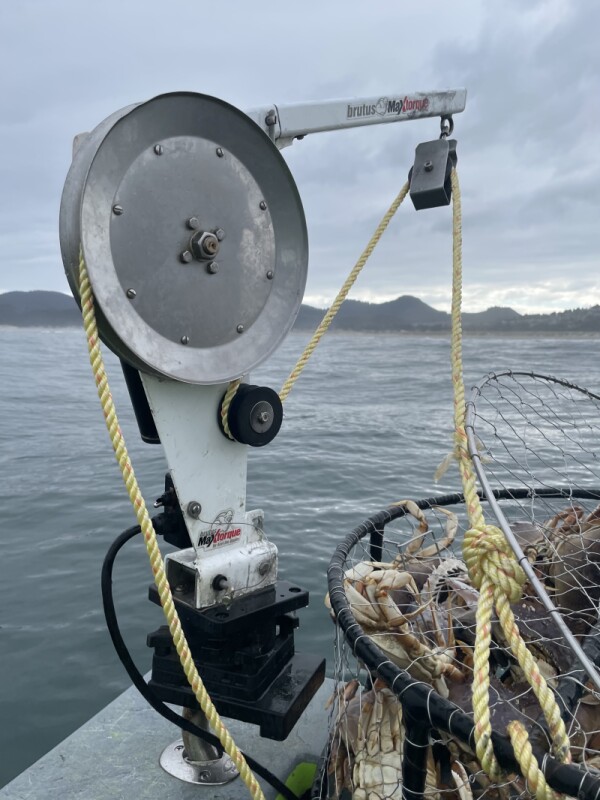
We lay to behind Haystack Rock, a rock that looks like a haystack rising almost 300 feet out of the water less than a mile offshore. Goins and Noffsinger set up the crab davit with an electric hauler. “I’ve got six pots,” says Goins. “I want to haul them all and bait them because I have a trip on Sunday.” I haul the first one, and even with the electric hauler, it’s kind of a beast. Noffsinger helps me bring the pot onto the rail, where he sets to empty it into a small live well.
“We get twelve each,” says Goins. With the traps hauled, and all our limits aboard, Goins heads for the beach.
“This is the easy part,” he says. “You just get behind a big wave and follow it in.” We roll in on the back of a wave and grind to a stop on the sand. It’s less dramatic than squaring off with big breakers. But it’s fun to see the other boats come in at top speed and slide up the beach.
A few commercial dories are still working in Pacific City. Dane Wenrick fishes for his family’s company, Sea Q Fish Company, and Tyler Kuhn and his family have West Fish Co., where they get top dollar selling their catches retail.
